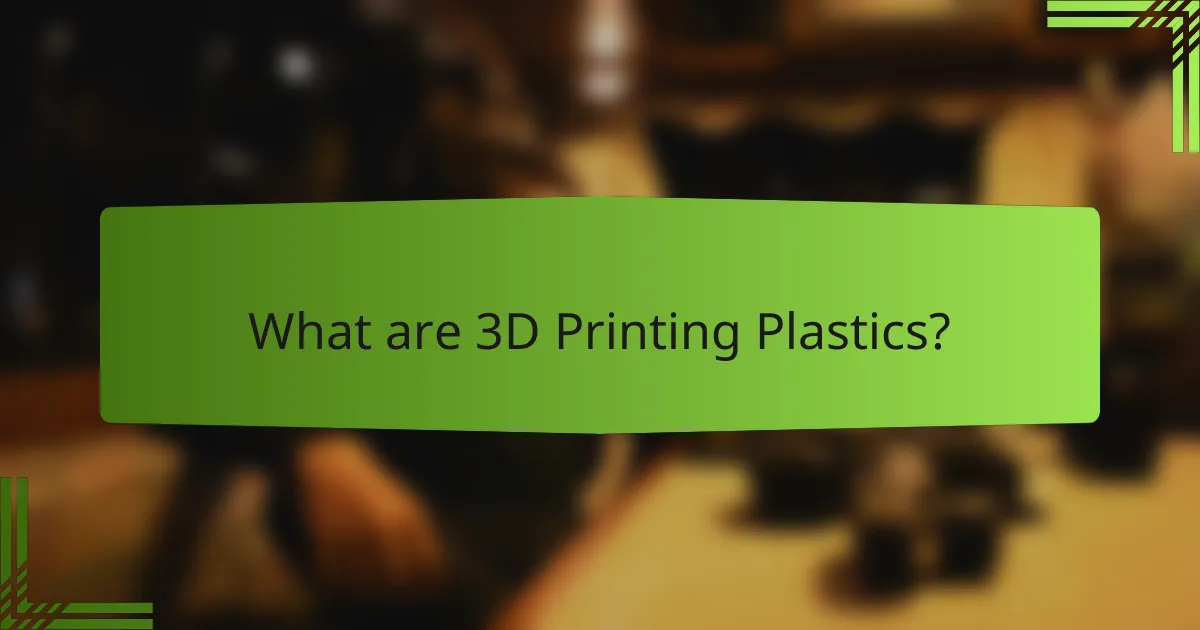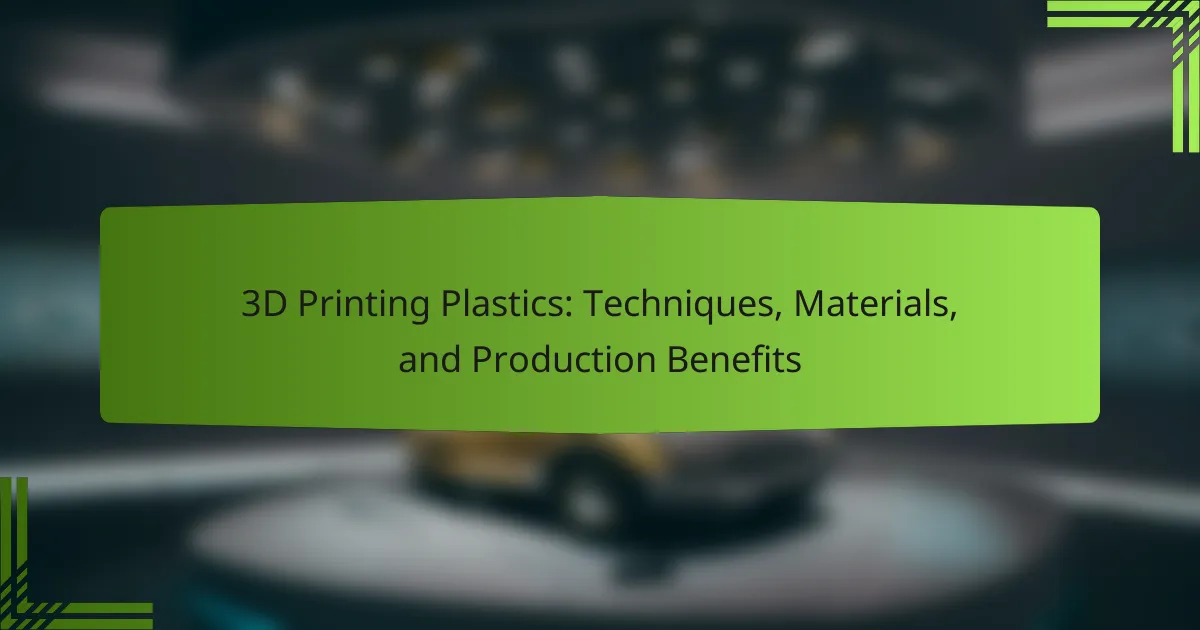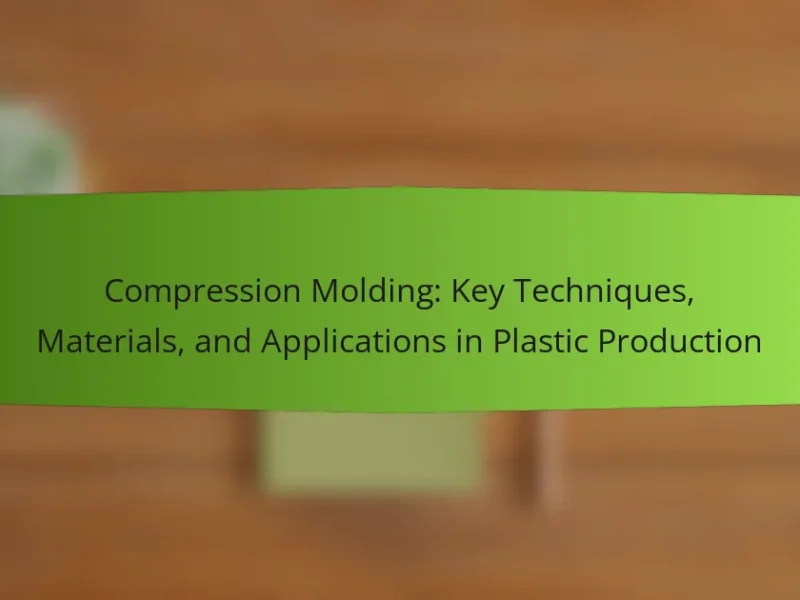3D printing plastics are specialized materials designed for additive manufacturing, allowing the creation of three-dimensional objects through a layer-by-layer process. This article explores various types of 3D printing plastics, including PLA, ABS, and PETG, highlighting their distinct properties and applications. PLA is recognized for its biodegradability and ease of use, while ABS offers strength and durability, and PETG combines user-friendliness with chemical resistance. The selection of plastic significantly influences the final product’s characteristics, such as flexibility and temperature resistance, making it crucial for diverse applications from prototypes to finished goods. The article also discusses the techniques involved in working with these materials and the benefits they provide in production.

What are 3D Printing Plastics?
3D printing plastics are materials specifically designed for additive manufacturing processes. They are used to create three-dimensional objects layer by layer. Common types include PLA, ABS, and PETG. PLA is biodegradable and easy to print. ABS is known for its strength and durability. PETG combines ease of use with chemical resistance. These materials enable a wide range of applications, from prototypes to finished products. The choice of plastic affects the final object’s properties, such as flexibility and temperature resistance.
How are 3D Printing Plastics classified?
3D printing plastics are classified primarily into two categories: thermoplastics and thermosetting plastics. Thermoplastics can be melted and reshaped multiple times. Common thermoplastics used in 3D printing include PLA, ABS, and PETG. These materials are favored for their ease of use and versatility. Thermosetting plastics, on the other hand, undergo a chemical change when heated, which makes them rigid and non-reversible. They are often used in applications requiring durability and heat resistance. Understanding these classifications helps in selecting the right material for specific 3D printing applications.
What are the common types of 3D Printing Plastics?
Common types of 3D printing plastics include PLA, ABS, PETG, and Nylon. PLA, or polylactic acid, is biodegradable and easy to print. ABS, or acrylonitrile butadiene styrene, is durable and heat-resistant. PETG, or polyethylene terephthalate glycol-modified, offers strength and flexibility. Nylon is known for its toughness and resistance to wear. Each plastic type has unique properties suited for different applications in 3D printing.
How do different plastics affect the 3D printing process?
Different plastics significantly influence the 3D printing process. Each type of plastic has unique properties that affect printing temperature, adhesion, and print quality. For example, PLA (Polylactic Acid) is known for its ease of use and low printing temperature, making it suitable for beginners. ABS (Acrylonitrile Butadiene Styrene) requires higher temperatures and has a tendency to warp, which can complicate the printing process. PETG (Polyethylene Terephthalate Glycol) combines the ease of PLA with the durability of ABS, offering a balance of strength and printability. Nylon is flexible and strong but can absorb moisture, impacting print quality. Each plastic’s viscosity and melting point directly affect the extrusion process, influencing layer adhesion and overall print accuracy. Understanding these differences helps in selecting the appropriate plastic for specific applications in 3D printing.
What are the key characteristics of 3D Printing Plastics?
3D printing plastics are characterized by their versatility, durability, and ease of use. These materials can be tailored for various applications, from prototyping to final products. Common types include PLA, ABS, and PETG, each with distinct properties. For instance, PLA is biodegradable and user-friendly, making it ideal for beginners. ABS offers higher strength and heat resistance, suitable for functional parts. PETG combines the best of both, providing strength and flexibility. Furthermore, 3D printing plastics typically exhibit good layer adhesion and can be printed at various speeds. Their compatibility with different 3D printers enhances their accessibility for users.
What properties make plastics suitable for 3D printing?
Plastics suitable for 3D printing possess several key properties. These include good thermal stability, allowing them to withstand high temperatures during the printing process. They also exhibit excellent adhesion between layers, which is crucial for structural integrity. Additionally, many 3D printing plastics have low shrinkage rates, reducing the risk of warping. Flexibility is another important property, enabling the creation of complex geometries. Furthermore, certain plastics offer chemical resistance, enhancing durability in various applications. These properties are validated by the widespread use of materials like PLA, ABS, and PETG in 3D printing.
How does the choice of plastic influence print quality?
The choice of plastic significantly influences print quality in 3D printing. Different plastics have unique properties that affect adhesion, flexibility, and surface finish. For instance, PLA provides excellent layer adhesion and a smooth finish, resulting in high-quality prints. Conversely, ABS can warp during printing, leading to reduced accuracy and surface defects. Additionally, the viscosity of the plastic affects the extrusion process. Higher viscosity materials may lead to inconsistent flow, impacting print resolution. Research indicates that using the appropriate plastic can enhance dimensional accuracy by up to 10% compared to using less suitable materials. Thus, selecting the right plastic is crucial for achieving optimal print quality in 3D printing.
What techniques are used in 3D Printing with Plastics?
Fused Deposition Modeling (FDM) is a primary technique used in 3D printing with plastics. FDM works by melting thermoplastic filaments and extruding them layer by layer. This method allows for the creation of complex geometries. Stereolithography (SLA) is another technique that utilizes a UV light source to cure liquid resin into solid plastic. SLA produces high-resolution prints with smooth finishes. Selective Laser Sintering (SLS) uses a laser to fuse powdered plastic materials into solid structures. SLS is known for its durability and ability to create functional parts. Each technique offers unique advantages for different applications in 3D printing.
How does Fused Deposition Modeling (FDM) work with plastics?
Fused Deposition Modeling (FDM) works by extruding heated thermoplastic filament through a nozzle. The nozzle moves in a predetermined path, depositing the melted plastic layer by layer. Each layer adheres to the previous one as it cools and solidifies. This process continues until the entire object is built. Common plastics used in FDM include PLA, ABS, and PETG. FDM is popular for its accessibility and cost-effectiveness in 3D printing. It allows for complex geometries and custom designs. The layer-by-layer approach enables precise control over the final object’s dimensions and features.
What is Selective Laser Sintering (SLS) and how is it applied?
Selective Laser Sintering (SLS) is a 3D printing technology that uses a laser to fuse powdered materials into solid structures. SLS typically employs thermoplastic powders, such as nylon, which are spread in layers and selectively melted by a laser. This process allows for the creation of complex geometries that traditional manufacturing methods cannot achieve.
SLS is applied in various industries, including aerospace, automotive, and healthcare. It is used for rapid prototyping, producing functional parts, and creating customized items. The method enables efficient production with minimal waste, as unused powder can be recycled for future prints. SLS also supports the production of lightweight yet durable components, which is critical in applications requiring high strength-to-weight ratios.
What are the production benefits of using 3D Printing Plastics?
3D printing plastics offer several production benefits. They enable rapid prototyping, significantly reducing development time. This technology allows for complex designs that traditional manufacturing cannot achieve. It minimizes material waste by using only the necessary amount of plastic. 3D printing also facilitates customization, meeting specific client needs effectively. The process can lower production costs, especially for small batch runs. Additionally, it supports on-demand production, reducing inventory costs. According to a study by Wohlers Associates, 3D printing can reduce lead times by up to 90%.
How does 3D printing with plastics reduce production costs?
3D printing with plastics reduces production costs by minimizing material waste and lowering manufacturing expenses. Traditional methods often involve subtractive processes that generate excess scrap. In contrast, 3D printing uses additive manufacturing, which builds objects layer by layer, utilizing only the necessary material. This efficiency leads to significant savings in raw material costs. Additionally, 3D printing allows for rapid prototyping, reducing the time and labor involved in product development. According to a study by Wohlers Associates, companies can save up to 70% in production costs by adopting 3D printing technologies. These factors collectively contribute to a more cost-effective manufacturing process.
What advantages does 3D printing offer in terms of design flexibility?
3D printing offers significant advantages in design flexibility. It allows for the creation of complex geometries that traditional manufacturing methods cannot achieve. Designers can easily modify designs without the need for expensive tooling changes. This technology supports rapid prototyping, enabling quick iterations based on feedback. Customization is straightforward, allowing for one-of-a-kind parts tailored to specific requirements. Materials can be combined in a single print, enhancing functional capabilities. Additionally, 3D printing minimizes waste by using only the necessary material for production. These factors collectively enhance the creative possibilities for designers and engineers.
How do 3D Printing Plastics impact various industries?
3D printing plastics significantly impact various industries by enabling rapid prototyping and customization. This technology allows manufacturers to create complex designs that traditional methods cannot achieve. In the automotive industry, 3D printing reduces the time and cost of producing parts. For example, companies can produce lightweight components that enhance fuel efficiency. In healthcare, 3D printing is revolutionizing prosthetics and implants. Custom-fit devices improve patient outcomes and comfort. The aerospace sector benefits from reduced material waste and faster production timelines. Additionally, the consumer goods industry utilizes 3D printing for personalized products. This flexibility meets diverse customer demands efficiently. Overall, 3D printing plastics drive innovation across multiple sectors by enhancing production capabilities and reducing costs.
Which sectors are most transformed by 3D Printing Plastics?
The sectors most transformed by 3D printing plastics include aerospace, automotive, healthcare, and consumer goods. In aerospace, companies utilize 3D printing for lightweight components that enhance fuel efficiency. The automotive industry leverages this technology for rapid prototyping and production of complex parts. Healthcare benefits from custom implants and prosthetics tailored to individual patients. Consumer goods see innovation through personalized products and efficient manufacturing processes. Each sector experiences significant cost savings and reduced lead times due to the adoption of 3D printing technologies.
What are the environmental implications of using 3D Printing Plastics?
The environmental implications of using 3D printing plastics include increased plastic waste and energy consumption. 3D printing often utilizes thermoplastics, which can contribute to pollution if not recycled properly. The production process can emit volatile organic compounds, impacting air quality. Additionally, the energy required for 3D printing can contribute to carbon emissions, depending on the energy source. Studies indicate that the lifecycle of 3D printed plastics can lead to significant environmental footprints if not managed effectively. For instance, a study published in “Science Advances” highlights the potential for 3D printing to generate waste comparable to traditional manufacturing methods.
What are the best practices for working with 3D Printing Plastics?
Use proper filament storage to prevent moisture absorption. Moisture can degrade the quality of 3D printing plastics. Maintain a consistent printing temperature to ensure optimal layer adhesion. This is crucial for materials like ABS and PLA. Calibrate the printer regularly for accurate dimensions and quality. A well-calibrated printer reduces errors and improves print success rates. Clean the print bed before each print to enhance adhesion. A clean surface minimizes the risk of warping and lifting. Select the appropriate nozzle size for the filament being used. Different filaments may require specific nozzle diameters for optimal flow. Monitor the cooling settings during printing. Proper cooling can prevent issues like stringing and sagging. Use supports when necessary for complex designs. Supports help maintain the integrity of overhangs and intricate features.
How can one optimize print settings for different plastics?
To optimize print settings for different plastics, adjust temperature, speed, and layer height according to the material type. For PLA, set the nozzle temperature between 180-220°C and use a print speed of 40-60 mm/s. For ABS, increase the nozzle temperature to 220-250°C and reduce speed to 30-50 mm/s. PETG requires a nozzle temperature of 220-250°C with a print speed of 40-60 mm/s.
Layer height should be set to 0.1-0.3 mm depending on the desired resolution. Additionally, use a heated bed for materials like ABS and PETG to prevent warping. Cooling fans should be used minimally for ABS but can be increased for PLA. Adjusting these settings ensures better adhesion, reduced stringing, and overall print quality.
What troubleshooting tips are essential for successful 3D printing with plastics?
Ensure proper bed leveling to enhance adhesion and prevent warping. Check nozzle temperature settings for the specific plastic being used. A temperature range of 190-220°C is common for PLA. Use the correct print speed; slower speeds improve print quality. Maintain consistent filament diameter to avoid extrusion issues. Monitor humidity levels as moisture can affect filament performance. Clean the nozzle regularly to prevent clogs. Use a suitable build surface, such as glass or PEI, for better adhesion. Adjust retraction settings to minimize stringing and oozing during prints.
3D printing plastics are specialized materials used in additive manufacturing, enabling the creation of complex three-dimensional objects. This article covers the classification of these plastics into thermoplastics and thermosetting plastics, detailing common types such as PLA, ABS, PETG, and Nylon, along with their unique properties and applications. It explores how different plastics influence the 3D printing process, the key characteristics that make them suitable for printing, and the techniques employed, including Fused Deposition Modeling (FDM) and Selective Laser Sintering (SLS). Additionally, the article discusses the production benefits of 3D printing plastics, their impact on various industries, environmental implications, best practices for usage, and essential troubleshooting tips for successful printing.


